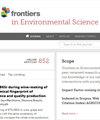随机森林、人工神经网络和支持向量机学习算法在预测土地利用-土地覆被时空动态方面的性能评估:以卢萨卡和科伦坡为例
IF 3.3
3区 环境科学与生态学
Q2 ENVIRONMENTAL SCIENCES
引用次数: 0
摘要
可靠的信息在可持续城市规划中发挥着关键作用。随着计算机技术的进步,地理信息学工具能够从空间和时间两个维度准确识别土地利用和土地覆被。鉴于需要精确的信息来加强决策,因此必须评估分类算法在检测 LULC 变化方面的性能和可靠性。虽然机器学习算法在 LULC 评估中的应用研究在许多国家都很普遍,但在赞比亚和斯里兰卡却仍然有限。因此,我们以卢萨卡和科伦坡市为研究区域,利用大地遥感卫星专题成像仪(TM)和业务土地成像仪(OLI),评估了支持向量机(SVM)、随机森林(RF)和人工神经网络(ANN)算法在检测 1995 年至 2023 年土地利用和土地覆被变化方面的可靠性和性能。结果显示,RF 和 ANN 模型表现出卓越的性能,在科伦坡的平均总精度 (MOA) 分别达到 96%,在卢萨卡的平均总精度 (MOA) 分别达到 96% 和 94%。同时,SVM 模型在 1995 年和 2023 年的总体准确率(OA)介于 77% 和 94% 之间。此外,与 ANN 和 SVM 模型相比,RF 算法在两个研究区域的 OA 和卡帕系数(介于 0.92 和 0.97 之间)明显略高。据观察,土地利用的主要变化是植被面积扩大了 11,990 公顷(60.4%),这主要是通过 1995-2005 年期间将卢萨卡的 1,926 公顷裸地转化为植被而实现的。然而,值得注意的变化是,从 2005 年到 2023 年,建筑密集区出现了显著增长,总面积增加了 25110 公顷(71%)。然而,尽管在 1995 年至 2023 年的整个期间,植被被转化为建筑密集区,但植被覆盖面积仍净增了 11,000 多公顷(53.4%)。就科伦坡而言,在此期间,建筑区扩大了 1,779 公顷(81.5%),而植被减少了 1,519 公顷(62.3%)。LULC 模拟还表明,在 2023-2035 年期间,卢萨卡的建成区面积扩大了 160 公顷。同样,科伦坡的建成区面积在同期也增加了 337 公顷。总体而言,RF 算法的表现优于 ANN 和 SVM 算法。此外,预测和模拟结果表明,在这两种情况下,建成区面积都呈上升趋势。由此绘制的土地覆被图为两国的城市规划和政策制定机构提供了重要的基准线。本文章由计算机程序翻译,如有差异,请以英文原文为准。
A performance evaluation of random forest, artificial neural network, and support vector machine learning algorithms to predict spatio-temporal land use-land cover dynamics: a case from lusaka and colombo
Reliable information plays a pivotal role in sustainable urban planning. With advancements in computer technology, geoinformatics tools enable accurate identification of land use and land cover (LULC) in both spatial and temporal dimensions. Given the need for precise information to enhance decision-making, it is imperative to assess the performance and reliability of classification algorithms in detecting LULC changes. While research on the application of machine learning algorithms in LULC evaluation is widespread in many countries, it remains limited in Zambia and Sri Lanka. Hence, we aimed to assess the reliability and performance of support vector machine (SVM), random forest (RF), and artificial neural network (ANN) algorithms for detecting changes in land use and land cover taking Lusaka and Colombo City as the study area from 1995 to 2023 using Landsat Thematic Mapper (TM), and Operational Land Imager (OLI). The results reveal that the RF and ANN models exhibited superior performance, both achieving Mean Overall Accuracy (MOA) of 96% for Colombo and 96% and 94% for Lusaka, respectively. Meanwhile, the SVM model yielded Overall Accuracy (OA) ranging between 77% and 94% for the years 1995 and 2023. Further, RF algorithm notably produced slightly higher OA and kappa coefficients, ranging between 0.92 and 0.97, when compared to both the ANN and SVM models, across both study areas. A predominant land use change was observed as the expansion of vegetation by 11,990 ha (60.4%), primarily through the conversion of 1,926 ha of bare lands into vegetation in Lusaka during 1995–2005. However, a noteworthy shift was observed as built-up areas experienced significant growth from 2005 to 2023, with a total increase of 25,110 ha (71%). However, despite the conversion of vegetation to built-up areas during the entire period from 1995 to 2023, there was still a net gain of over 11,000 ha (53.4%) in vegetation cover. In case of Colombo, built-up areas expanded by 1,779 ha (81.5%), while vegetation land decreased by 1,519 ha (62.3%) during concerned period. LULC simulation also indicated a 160-ha expansion of built-up areas during the 2023–2035 period in Lusaka. Likewise, Colombo saw a rise in built-up areas by 337 ha within the same period. Overall, the RF algorithm outperformed the ANN and SVM algorithms. Additionally, the prediction and simulation results indicate an upward trend in built-up areas in both scenarios. The resultant land cover maps provide a crucial baseline that will be invaluable for urban planning and policy development agencies in both countries.
求助全文
通过发布文献求助,成功后即可免费获取论文全文。
去求助
来源期刊

Frontiers in Environmental Science
Environmental Science-General Environmental Science
CiteScore
4.50
自引率
8.70%
发文量
2276
审稿时长
12 weeks
期刊介绍:
Our natural world is experiencing a state of rapid change unprecedented in the presence of humans. The changes affect virtually all physical, chemical and biological systems on Earth. The interaction of these systems leads to tipping points, feedbacks and amplification of effects. In virtually all cases, the causes of environmental change can be traced to human activity through either direct interventions as a consequence of pollution, or through global warming from greenhouse case emissions. Well-formulated and internationally-relevant policies to mitigate the change, or adapt to the consequences, that will ensure our ability to thrive in the coming decades are badly needed. Without proper understanding of the processes involved, and deep understanding of the likely impacts of bad decisions or inaction, the security of food, water and energy is a risk. Left unchecked shortages of these basic commodities will lead to migration, global geopolitical tension and conflict. This represents the major challenge of our time. We are the first generation to appreciate the problem and we will be judged in future by our ability to determine and take the action necessary. Appropriate knowledge of the condition of our natural world, appreciation of the changes occurring, and predictions of how the future will develop are requisite to the definition and implementation of solutions.
Frontiers in Environmental Science publishes research at the cutting edge of knowledge of our natural world and its various intersections with society. It bridges between the identification and measurement of change, comprehension of the processes responsible, and the measures needed to reduce their impact. Its aim is to assist the formulation of policies, by offering sound scientific evidence on environmental science, that will lead to a more inhabitable and sustainable world for the generations to come.
 求助内容:
求助内容: 应助结果提醒方式:
应助结果提醒方式:


